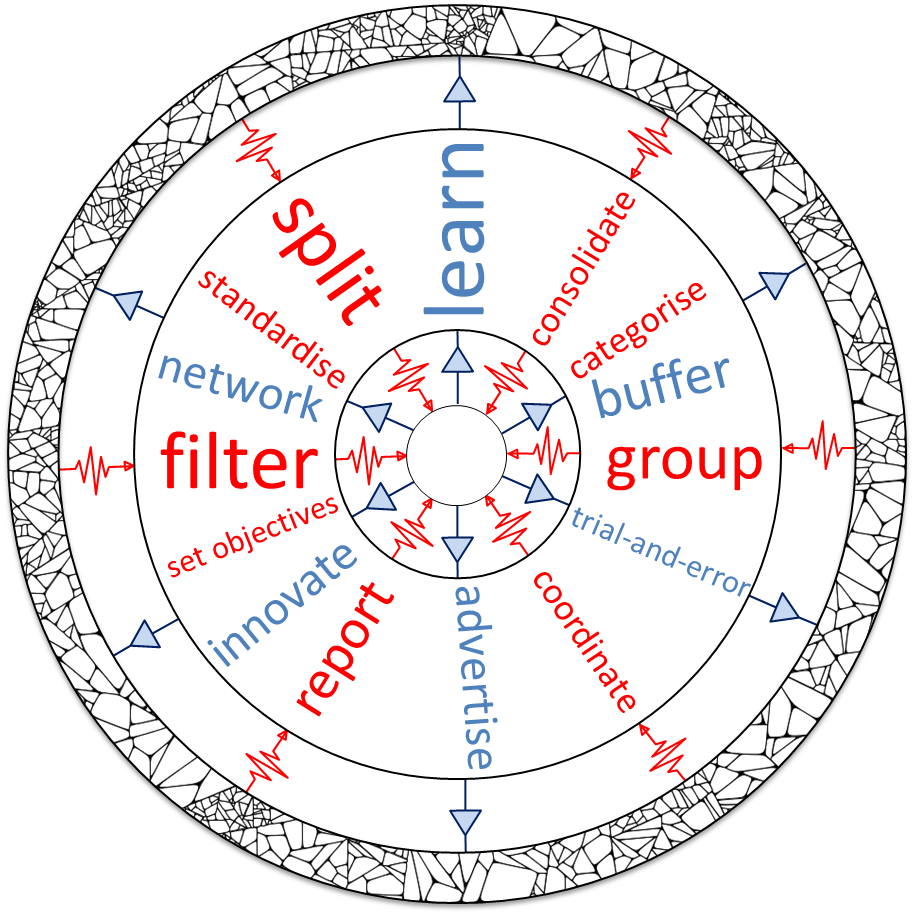Variety – part 2
Blog: Strategic Structures
Can you deal with it? It is amazing how language evolved to adapt to reductionist mindset. “Deal”, which originated from divide and initially meant only to distribute and then to trade, is now used as synonym for cope, manage and control. We manage things by dividing them. We eat elephants peace by peace, we start journeys of thousand miles with a single step, and we divide to conquer.
(This is the second part of a sequence devoted to the concept “variety” used as a measure of complexity. It’s a good idea to read previous part before this one but even doing it after, or not at all is fine.)
And that indeed proved to be a good way of managing things, or at least some things, and in some situations. But often it’s not enough. To deal with things, and here I use “deal” to mean manage, understand, control, we need requisite variety and when that is not the case initially, we could get it in three ways: by attenuating the variety of what has to be dealt with, by amplifying our variety, or by doing a bit of both when the difference is too big.
And how do we do that? (I use we/them instead of regulator/regulated or systemA/systemB or organisation/environment, because I find it easier to imply the perspective and the purpose this way) Let’s start with an attempt to put some very common activities in each of these groups. We attenuate external variety by grouping, categorising, splitting, standardising, setting objectives, filtering, reporting, coordinating, and consolidating. We amplify our variety by learning, trial-and-error, practising, networking, advertising, buffering, doing contingency planning, and innovating. And we can add a lot more to both lists, of course. We use activities from both list but when doing these activities we need requisite variety as well. That’s why we have to apply them at the lower level of recursion. We learn to split and we split to learn, for example.
It could be easy to put in the third group pairs from each list but now the task is to classify single types. Here are two suggestions that seem to fit: planning and pretending.
With planning we get higher variety by being prepared for at least one scenario, especially in the parts of what we can control, in contrast to those not prepared even for that. But then, we reduce different possibilities to one and try to absorb part of the deflected variety with risk management activities. Planning is important in operations and projects but somehow in the business setting we can get away with poor planning, at least for long enough to lose the opportunity to adapt. And that is the case in many systems with delayed feedback. That’s why I like the test of quick-feedback and skin-in-the-game situations, like sailing. In sailing, not having a good plan could be equality disastrous as sticking to a plan for too long and not adapting or replacing it quickly based on evidence against the assumptions of the initial one. And that’s valid at every level, no matter if the plan is for a week, day or an hour.
Pretending is even more interesting in its dual role. It can be so successful as to reinforce its application to the extreme. Pretending is so important for stick insects, for example, that they apply it 24/7. That proved to be really successful for their survival and they’ve been getting better at it for the last fifty million years. It turned out to be also so satisfactory that they can live without sex for one million years. Well, that’s for a different reason but nevertheless their adaptability is impressive. The evolutionary pressure to better resemble sticks made them sacrifice their organ symmetry so that they can afford thinner bodies. Isn’t it amazing: you give up one of your kidneys just to be able to lie better? Now, why do I argue that deception in general, and pretending in particular, has a duel role in the variety game? Stick insects amplify their morphologic variety and through this they attenuate the perception variety of their predators. A predator sees stick as a stick and stick insect as a stick, two states attenuated into one.
Obviously snakes are more agile than stick insects but for some types that agility goes beyond the capabilities of their bodies. Those snakes don’t pretend 24/7 but just when attacked. They pretend to be dead. And one of those types, the hognose snake, goes so far in their act as to stick its tongue out, vomit blood and sometimes even defecate. Now, that should be not just convincing but quite off-putting even for the hungriest of predators.
If pretending can be such a variety amplifier (and attenuator), pretending to pretend can achieve even more remarkable results. A way to imagine the variety proliferation of such a structure is to use an analogy with the example of three connected black boxes that Stafford Beer gave in “The Heart of Enterprise”. If the first box has three inputs and one output, each of them with two possible states, then the input variety is 8 and the output is 256. Going from 8 to 256 with only one output is impressive but when that is the input of a third black box, having only one output as well, then its variety reaches the cosmic number of 1.157×1077.
That seems to be one of the formulas of the writer Kazuo Ishiguro. As Margaret Atwood put it, “an Ishiguro novel is never about what it pretends to pretend to be about”. No wonder “Never Let Me Go” is so good. And the author, having much more variety than the stick insects, didn’t have to give his organs to be successful. He just made up characters to give theirs.
Leave a Comment
You must be logged in to post a comment.








